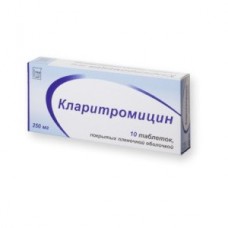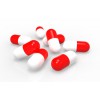Expiration date: 09/2026
General characteristic. Composition:
Active ingredient: 1 tablet contains clarithromycin 250mg or 500mg,
excipients: microcrystalline cellulose, polyvinylpyrrolidone, talc purified, magnesium stearate, Aerosil, sodium krakhmalnikova, starch, hydroxypropyl methylcellulose, titanium dioxide, Indigo Carmine dye, and the dye Ponceau 4R (for a dosage of 250 mg), quinoline yellow (Lac) (for dosing 500 mg).
Pharmacological properties:
Clarithromycin is an antibiotic of the macrolide group, a semi-synthetic derivative of erythromycin. The modified structure of the molecule makes the drug more bioavailable, stable in an acidic environment, increases concentration in tissues, expands antimicrobial spectrum, lengthens the half-life, which makes it possible to prescribe the drug twice a day and thereby improve the quality of treatment of patients. After oral administration Clarithromycin is rapidly absorbed, reaching a maximum concentration in 2-3 hours. Excreted in the urine 36% of the dose in the feces of 52 %.
Indications for use:
Infections, caused by susceptible to Clarithromycin microorganisms:
- infections of the upper respiratory tract (pharyngitis, sinusitis, tonsillitis),
- lower respiratory tract infections (bronchitis, community-acquired pneumonia, hospital),
- infections of the skin and soft tissues (folliculitis, erysipelas, streptoderma, staphyloderma),
- common or localized Mycobacterium infections caused by Mycobacterium avium or Mycobacterium intracellulare, localized infections caused by Mycobacterium chelonae, Mycobacterium fortuitum, Mycobacterium kensasii,
- common infections caused by Mycobacterium avium complex in HIV-infected patients with CD4 lymphocyte,
- which is less than or equal to 100 / mm3,
- odontogenic infections.
Clarithromycin is used simultaneously with drugs to inhibit the acidity of gastric juice for the eradication of H. pylori in the treatment of duodenal ulcer.
Method of application and doses:
If the doctor has not prescribed otherwise, then for adults and children over 12 years, the average dose is 250 mg 2 times a day. If necessary, Clarithromycin can be taken at 500 mg 2 times a day. The duration of treatment - 5-14 days, except community-acquired pneumonia and sinusitis, which requires treatment for 6-14 days.
Children up to 12 years the drug is prescribed in another pharmaceutical form.
Dosage for patients with kidney and liver lesions is determined by the doctor, respectively, the degree of insufficiency of function.
In patients with severe impairment of renal function (creatinine clearance less than 30 ml/min), the dose of Clarithromycin should be corrected. Such doses are offered:
In the treatment of mycobacterial infections recommended dose for adults is 500 mg, 2 times a day.
Treatment of common mycobacterial infections of patients with AIDS should be continued until the clinical and microbiological state is improved. Clarithromycin should be used in conjunction with other antimicrobial drugs.
Treatment of nontuberculous mycobacterial infections should continue at the discretion of the physician.
The recommended dose for the prevention of mycobacterial infections is 500 mg, twice a day.
For the treatment of odontogenic infections, the recommended dose is 1 tablet of 250 mg twice a day for 5 days.
For H. pylori eradication, such treatment regimens are offered.
Treatment regimen with three drugs:
500 mg of Clarithromycin twice a day, along with proton pump inhibitor (e.g. lansoprazole, pantoprazole, omeprazole) in the appropriate dose and amoxicillin 1000 mg twice a day for 10 days.
Scheme of baking with two drugs:
500 mg Clarithromycin, three times a day, at the same time as taking the proton pump inhibitor (e.g. pantoprazole, omeprazole) at the appropriate dose, for 14 days, then take the proton pump inhibitor (pantoprazole, omeprazole) at the appropriate dose, for the next 14 days.
Features of application: before treatment, consult your doctor!
Clarithromycin should be taken with caution in patients with impaired liver and/or kidney function, as well as elderly patients.
In patients with renal insufficiency, the dosage and duration of administration of the drug is determined by the doctor.
In the first three months of pregnancy, the drug is prescribed only for absolute indications.
Data on the use of the drug during lactation are not available.
The influence on the ability to drive vehicles and machinery is not established.
If within a few days the state of health has not improved, you should consult a doctor.The drug can be taken with food, milk and on an empty stomach.
You should stick to the regime and treatment regimens throughout the course of therapy. Missed dose should be taken as soon as possible, do not take the dose, if it is almost time to take the next dose, you can not double the dose.Side effects:nausea, vomiting, change of taste, epigastric pain, diarrhoea, tranzithornoe increase in liver transaminaz, allergic reactions (urticaria, skin rash, in rare cases - anaphylaxis and Stevens-Johnson syndrome), temporary side effects from the CNS (headache, dizziness, amuseneering, insomnia, disturbing dreams, tinnitus, confusion, disorientation, hallucinations, psychosis and depersonalization, glossitis, stomatitis, fungal infection of the oral mucosa and discoloration of the tongue, hypoglycemia, leukopenia and thrombocytopenia, pseudomembranous colitis. Like other macrolide antibiotics in the application of Clarithromycin, prolongation of the QT interval, tachycardia and trembling/flickering of the ventricles are possible.
During treatment with Clarithromycin, superinfections caused by resistant bacteria or fungi may occur, in which case it is necessary to refuse treatment with the drug.
In case of any unusual reactions, be sure to consult your doctor regarding the further use of the drug!Interaction with other medicines:if you are taking any other medicines, be sure to let the doctor know!
When concomitant administration of Clarithromycin with theophylline, carbamazepine, astemizole, ergot alkaloids, triazolam, midazolam, cyclosporine increases content in the blood plasma.
Co-administration of Clarithromycin and terfenadine resulted in a increase in 2-3 times the concentration of the acid metabolite of terfenadine in the blood serum, as well as to changes on the electrocardiogram, which was not accompanied by clinically significant symptoms.
Coadministration of Clarithromycin with cisapride, pimozide may lead to prolongation of the QT interval and cardiac arrhythmias.
With simultaneous use of Clarithromycin with quinidine or dizopiramidom possible cases of flicker/trembling of the ventricles. It is necessary to control the level of these drugs in the blood during treatment with Clarithromycin.
When taking Clarithromycin at the same time digoxin may increase the concentration of digoxin in serum, which requires in such cases control over its level.
With simultaneous use of Clarithromycin and rifampicin or rifabutin the concentration of Clarithromycin in the blood serum decreases (greater than 50 %).
When used simultaneously with Clarithromycin, the action of warfarin increases. Therefore, patients taking warfarin, it is necessary to control prothrombin time.
With simultaneous administration of Clarithromycin and HMG-COA reductase inhibitors such as lovastatin or simvastatin, rhabdomyolysis was rarely observed.
The simultaneous use of tablets Clarithromycin and zidovudine HIV-infected patients can cause a decrease in constant levels of zidovudine in the blood. But this interaction is not observed in HIV-infected children with concomitant use of Clarithromycin suspension with zidovudine or dideoxyinosine.Contraindications: Clarithromycin is contraindicated in patients with hypersensitivity to macrolides.
The drug in this form is not prescribed to children under 12 years.Overdose: with an overdose, gastrointestinal disorders (nausea, vomiting, diarrhea) are possible.
Therapeutic measures in overdose is directed to the removal of substances from the body with domostroyenie stomach probe and holding of General support activities. Hemodialysis or peritoneal cialissideeffects.Storage conditions:Store in a dry, protected from light and inaccessible to children place at temperature not above 25 °C. you should Not use the medicine after the expiry date stated on the package.
Shelf life-2 years.Conditions of release: prescription packing: coated tablets, 250 mg, 500 mg ? 10 in contour cell packs and ?10 In plastic containers.





